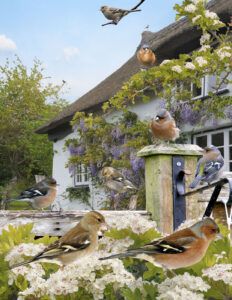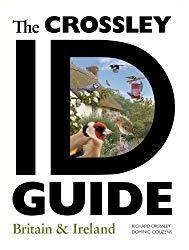You can buy items discussed below via links on this page. If you make a purchase we may receive a commission, at no extra cost to you, and for which we thank you very much! Read more about our affiliate policy.
Every garden birdwatcher needs a good bird field guide. Often, however, you find books that are overly simplified to discuss just a few common garden birds, or confusingly cover all the species in the country including rarities, and not just birds that you are actually likely to see. Whilst the Crossley ID Guide: Britain & Ireland is not specifically a garden bird book, it excludes very rare species and is not too overwhelming. Most interestingly, its novel approach means that this is the closest you get to how you see your garden birds from the kitchen window without binoculars!

Traditionally photographic guides have never managed to capture sufficient variety and information to match the best of the more ‘traditional’ guides with artwork. Richard Crossley’s Crossley ID Guide: Britain & Ireland attempts to rectify this, using a presentation approach that teaches the reader/viewer to observe and develop as a better birder.
I’m a big fan of Richard Crossley. Aside from, as a fellow ex-pat Brit, his retained accent bringing me a fond sense of nostalgia, he understands ‘how’ to watch birds, and writes and talks in a way that gets points across simply to beginners and experts alike. I often use his ‘Becoming a Better Birder’ video in introductory talks to birdwatchers anywhere in the world. The introductory section in this book covers the same ground and is excellent in talking through the process of bird identification – probably the best of any recent field guide and a recommended refresher for experienced birders too.

The unique thing about the Crossley ID Guide is that the many (about 5,000) photographs are digitally cut out of their original settings and placed, alongside others of the same species, in a single shot of a landscape. Birds are sized appropriately to appear at a variety of scales from near to far (from the hanging bird feeder close to the garage, to the bird table at the end of the garden) to give an impression of what birds look like in real-life, maybe even through the window from the comfort of your living room! The multitude of photos also means that both males and females as well as young birds are illustrated.
Admittedly, the resulting overall images are not especially realistic with a bewildering number of individuals sometimes in the same plate. We certainly don’t want 15 Sparrowhawks in our gardens at the same time, or there’ll be no other birds left! Broadly though, once one gets used to this, the approach definitely gives the birdwatcher a feel for the real in-field impression of the species.

The photos are the main part of the book but the accompanying text by Dominic Couzens is engaging and concise. Each of the regular species also has a small map depicting its distribution. Species are arranged in logical order related to habitat rather than being based on traditional taxonomic relations. This is much more helpful for identification, with most of the regular garden birds all grouped together. It also avoids the need to use the ‘quick’ visual index to all species at the front of the book which, presumably to save space, disappointingly uses unfamiliar five character short names rather than the full species names.
With so many evocative plates it’s difficult to pick a favourite. Redwings and Fieldfares in the snow are both lovely, as are Blue Tits in a country garden to be jealous of! What is your favourite? Let us know below.
Conclusion
Overall the Crossley ID Guide: Britain and Ireland is very good value and I personally use and recommend it. Whilst it is not purely a garden book it has excellent pages for all our garden birds, and is ideal for those who might sometimes venture further afield and still be interested in the birds they see.
Check out the other Crossley ID Guides if you are travelling to North America!



